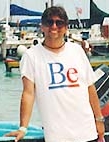
interviews
visit mikepop.net for more info about Mike Popovic

|
interviews |
|
|
visit mikepop.net for more info about Mike Popovic |
||
 "The most rewarding experience? Being a part of the Be Team."
"The most rewarding experience? Being a part of the Be Team."
Few realize that world champion paper airplane folder Joe Palmer is the same Joe Palmer who is responsible for designing the BeBox. He is also the author of The View From Here, a popular series of articles observing life in Silicon Valley.
Palmer: How did you first hear of Be, and who/what made you decide to sign on with Be? I was having lunch with David Ramsey, (Who was then at Be) at about the time that I was finishing off the 660AV at Apple. He couldn't tell me anything about what Be was doing, but he really liked the work environment. A couple weeks later I got an interview with Jean-Louis. I'd been looking into the PReP proposal at Apple, and the Hobbit had just been cancelled, so I suggested Be build a PPC machine, on the assumption that Apple and Microsoft would deliver OS components for PReP. When Jean-Louis gave me the chance to build that machine, I jumped at it. How do you start designing a machine with a "blank slate", for an operating system that did not even exist at the time? Honestly, I didn't. 90% of the BeBox schematic is the PReP design, with the other 10% is the extra I/O ports. In physics, researchers stand on the shoulders of the giants who came before. In computer design we stand on our data books. (I had a lot of data books.) Was there anything in particular that inspired parts of the BeBox? I really wanted to make sure that the internals were relatively accessible. I'd also worked on the 840AV at Apple, and was really miffed that the industrial design had driven the product, so you ended up with having to remove the motherboard to add RAM SIMMs. Jean-Louis suggested the port which later became the GeekPort(tm), and one morning he came in cross because he'd run out of serial ports on his Mac at home, so the BeBox got 4. Were the pulse/geek lights showing CPU load your invention as well? No, they were first proposed by David Ramsey, and Guillume Desmarets developed the code for the display PALs. I designed the interconnect and the single layer board (With the integrated Be Logo that the LEDs were on.) The rest is software. What was your most frustrating experience in designing/building the BeBox? The most rewarding? Frustrating? That would have to be getting an industrial design for the front panel. The back was easy, everything is exactly where I put it for layout and EMI. The front was a real effort. We worked with a designer from France for a while, but he lacked computer background, so he had no basis to make the required design trade-offs. He was a real giggle to work with though, all full of energy and style. (He also had a great tie with little plastic fish floating in it!) The most rewarding experience? Being a part of the Be Team. Did you hide any "easter eggs" in the BeBox? In hardware? No. I did name one of the ASICs "Kasumi" after the oldest of the Tendou Sisters, but Larry Thompson (Who programmed the ASICs) couldn't remember Akane an Nabiki, so he called them "Master & Slave" Strangely enough, "Kasumi" was deleted from the block digram as printed in the "BeBox GuideBook" in Japan, which is where the name came from. Although it must have been a terrible blow to take personally, do you think Be did the right thing in discontinuing the BeBox? Yes, it was the right thing then, and the events since then have only proven the wisdom of that decision. We had started a follow-on machine based on 604's, but AIM (Apple, IBM, Motorola) went full out on the G3, which is a poor candidate for SMP. Besides, Apple's post-NeXT position on the BeOS would have made getting timely CPU information out of the AIM alliance all but impossible. Once the BeOS ran on the PowerMacs, the genie was out of the bottle. Prior to making the BeBox decision, I'd had words with Jean-Louis and told him that I though there were 2 ways to go, The first was an upscale machine, (Which meant small volumes and lots of development effort to keep ahead of the pack) and the second was to drop hardware, (and put all efforts behind the software.) At that time most of the interest had turned to the BeOS on PowerMac hardware, and since there was no way that Be was going to be able to develop the same economies of scale (with only a high end machine), it made sense to stick a fork in it and call it done. What are you working on these days? My new venture is called VideoS2 (web-unique and short for "Video Storage Systems") I'm building a Digital Video Recorder. It's a rack mount box, filled with a wide array of hard drives. It can capture or playback video, in all standard digital uncompressed formats. This system, along with a Pentium II class PC can deliver the exact same image quality* as a $200,000 Quantel box, but at a price in contact with lossy JPEG or MPEG compression based systems. (*) Actually better, since the Quantel only supports 8 bits per component, and the VS2-DDR can support 10 bits (or more if you need them) per component. The basic idea is to add to a computer that 'stuff' needed to bring it up to the level of real video, rather than degrading the video to make it fit in the computer. Do you still use the BeBox/BeOS on a daily basis? mumble mumble Ah...well..., no. At the beginning of the year I had been using my BeBox for all of my web page work and email, but at that time I was on a very active mailing list and since a number of the messages came in with the mailing list on the "CC" line I had no way to filter those messages off. The CC field was not (And is still not in R4.. Grrr.) saved as a separate file attribute. I switched to Eudora on Windows which could keep do all of the filtering I needed to keep the mailing list separated from other messages. I was also downloading a lot of PDF files for my new product, and I had no good way to view and print them on the BeOS. (In fact, both of my laser printers are rather old, and are not supported by the BeOS. Sigh.) I've just put R4 on my Intel box, (With Japanese Support) and I'm now rediscovering the joys of the BeOS. (3.1 was just not very compatible with my machine.) I still find using the BeOS more comfortable than Windows, or the Mac, and anyway my poor 840AV is just too slow compared to my 400 MHz PII to use any more. Do you ever use your fame as "designer of the BeBox" to get better tables at restaurants? No, I've never tried that. I did ask the W3 for better tables in HTML4 (I wanted the width to be specified in "M" spaces) but they turned me down and told me to use style sheets, even though that feature still doesn't work on any browser I've tried. What is your favorite computer game? It hasn't been written yet. I want a helicopter game that uses two joysticks, one for cyclic, and one for the collective, just like a real helicopter. When I pull (or is it push?) on the cyclic, I expect to tilt and slip forward and downward. Yup, that means I'll need to bring in a little more collective to keep my altitude, and that extra torque will mean I'll need little more petal to keep from spinning on my rotor. (Okay, there's no foot pedals in the game, but you could use the other axis of the collective joystick). Sure, you're going to need a little more skill (And joysticks without dead zones in the center) to play that game, but isn't that really the next step in games? Who needs another twitchy- thumb shoot-em-up-blood-and-guts when you could write a game that gave the player a great direct-control analog interactive experience? It's odd, since I use a computer all day, and it seems all high tech and advanced, but then at the end of the day I walk in the other room and pick up a guitar. Those few ounces of carved wood, bits of metal and strings (all invented over a hundred years ago) is more responsive and expressive than my computer. I'll buy a computer 'game' when it starts to give me that responsiveness. (BTW, a great lot of sound cards and joysticks were sold because of DOOM. I could see a lot of copies of the BeOS installed just for this sort of game) What books (work-related and otherwise) do you consider a must-read? "Ranma 1/2" (Volumes 1-38), by Rumiko Takahashi (It might help if you know to read a little Japanese) "Monument" by Lloyd Biggle Jr. (Great and gentle science fiction. Heck, all of his works are well worth the read) "Story" by Robert McKee (It's about screenwriting, but it also applies to prose fiction.) "The Long Dark Tea Time of the Soul" by Douglas Adams. (If you could paint with words, this book would be the Mona Lisa.) If the BeOS was an animal, what kind would it be? Some kind of bird... a Falcon perhaps. Something that flies above the other Operating systems roaming around on the ground. Who is your favorite muppet, if any, and why? The newscaster, 'cause he told my favorite muppet joke: "Today the music director of the local symphony was nearly killed when during practice today when he accidentally stuck his baton into a light socket. Fortunately, his life was spared because he was bad conductor."Then the muppet conductor (Who was modeled after Arthur Fiedler) come on the set and whapped the newscaster. Maybe you had to see it. Finish this sentence: "Working with the BeOS kicks ass because _____________ ...it puts you in charge." |
Mike Clifton Scott Barta Joe Palmer Seth Flaxman Scot Hacker Michael Alderete Melanie Walker Dominic Giampaolo Douglas Irving Repetto |
|
Home | qJLG | Icon Tarot | Story Archive | Interviews | Bookstore | Newsletter | About | Advertise | Contact |